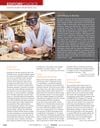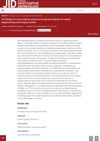
Search
for
Sort by
Research
180-210 / 240 results

research Self-Efficacy Is the Key: Impact of Undergraduate Research Experiences on Research Skills and Career Aspirations
Undergraduate research experiences boost students' research skills, confidence, and career aspirations.

research Stroke Recovery: Generation of Highly Pure Astroglia Progenitors from Human Embryonic Stem Cells and Their Neuroprotective Effects
Transplanted human Olig2+ astroglia may help improve learning and memory after a stroke.
research Marie-Unna Hereditary Hypotrichosis or Autosomal Recessive Hereditary Hypotrichosis with Woolly Hair: The Diagnostic Dilemma of Labeling Cases with Hypotrichosis
research Engineered Extracellular Vesicle Mimetics from Macrophage Promotes Hair Growth in Mice and Human Hair Follicle Growth
Engineered vesicles from macrophages help hair growth in mice and humans.
research Mast Cell Hyperplasia in the Skin of Dsg4-Deficient Hypotrichosis Mice, Long-Living Mutants of Lupus-Prone Mice
A gene mutation in mice causes increased mast cells and disorganized hair follicles in their skin.

research Case of Autosomal Recessive Woolly Hair/Hypotrichosis with Compound Heterozygous Mutations in the LIPH Gene at c.742C > A and c.614A > G: The First Japanese Case
The first Japanese case of a genetic hair disorder caused by specific mutations in the LIPH gene was identified.

research Design of a New Molecule Proven to Be Safe and Effective for Topical Depigmenting and Antiaging Method
A new molecule was found to be a safe and effective skin lightener and anti-aging product.
research Y27632 Promotes Proliferation via EGFR Signaling in a Newly Isolated and Characterized Human Primary Sebocyte Cell Line
Y27632 increases cell growth through EGFR signaling, not ROCK1/2.
research Polycystic Ovary Syndrome (PCOS): An Inflammatory, Systemic, Lifestyle Endocrinopathy
PCOS is a complex condition in women that can lead to health issues, and lifestyle changes are the best management approach.
research Microneedles in the Clinic: A Comprehensive Review of Clinical Studies and Applications
Microneedles are being used and tested for various medical and cosmetic treatments.
research Epidermal Stem Cells in Wound Healing and Their Clinical Applications
Epidermal stem cells help heal severe skin wounds and have potential for medical treatments.
research Desmoglein 4 Is Regulated by Transcription Factors Implicated in Hair Shaft Differentiation
Desmoglein 4 is controlled by specific proteins that affect hair growth.
research Opposing Impacts on Healthspan and Longevity by Limiting Dietary Selenium in Telomere Dysfunctional Mice
Low selenium levels can extend lifespan but worsen health issues.
research A Novel Mutation in Hr Causes Abnormal Hair Follicle Morphogenesis in Hairpoor Mouse, an Animal Model for Marie Unna Hereditary Hypotrichosis
A new mutation in the Hr gene causes hair loss in mice, similar to a human hair disorder.
research Epigenetic Age Estimation in Saliva and Buccal Cells
The model accurately predicts age from saliva and buccal cells for forensic use.
research The Circular RNA circNlgn Mediates Doxorubicin-Induced Cardiac Remodeling and Fibrosis
A specific RNA, circNlgn, contributes to heart damage and scarring caused by the cancer drug doxorubicin.

research Are Sex Hormones Promising Candidates to Explain Sex Disparities in the COVID-19 Pandemic?
Sex hormones like estrogen and testosterone may affect COVID-19 severity differently in men and women, potentially influencing prevention and treatment strategies.
research Establishment and Characterization of a Radiation-Induced Dermatitis Rat Model
Researchers created a rat model to study skin damage caused by radiation, which could help develop new treatments.

research Toll-Like Receptor 4 (TLR4): New Insights into Immunity and Aging
TLR4 is important in aging-related diseases and could be a new treatment target.
research Immunopathology and Immunotherapy of Inflammatory Skin Diseases
New targeted immunotherapies are improving treatment for inflammatory skin diseases.

research Platelet-Rich Plasma Stimulates Angiogenesis in Mice Which May Promote Hair Growth
Platelet-rich plasma can help grow more and longer hair by creating new blood vessels.
research Effect of Cyclosporin on Hair-Existing Area of Nude Mice
Cyclosporin extends hair growth in mice, but high-dose corticosteroids block this effect.
research Effects of Periplaneta Americana Extracts on the Growth and Proliferation of Cutaneous Interstitial Cells in Cutaneous-Wound Healing
Kangfuxin (KFX) extract speeds up wound healing and improves skin regeneration.
research Therapeutic Values of Exosomes in Cosmetics, Skin Care, Tissue Regeneration, and Dermatological Diseases
Exosomes could be effective for improving skin health and treating skin diseases.

research Hyaluronic Acid-FGF2-Derived Peptide Bioconjugates for Suppression of FGFR2 and AR Simultaneously as an Acne Antagonist
The new anti-acne treatment HA-P5 effectively reduces acne by targeting two key receptors and avoids an enzyme that can hinder treatment.

research Application of Extracellular Vesicles From Mesenchymal Stem Cells Promotes Hair Growth by Regulating Human Dermal Cells and Follicles
Using extracellular vesicles from stem cells can help hair grow by affecting scalp cells and hair follicles.

research Skin Microbiome, Metabolome and Skin Phenome, from the Perspectives of Skin as an Ecosystem
Your skin is like an ecosystem, with its own community of microbes and substances that interact and affect its health.
research The Effect of EGR1 on the Proliferation of Dermal Papilla Cells
Increasing EGR1 levels makes hair root cells grow faster.
research Potential of Colostrum-Derived Exosomes for Promoting Hair Regeneration Through the Transition from Telogen to Anagen Phase
Colostrum-derived exosomes can promote hair growth and may be a promising treatment for hair loss.